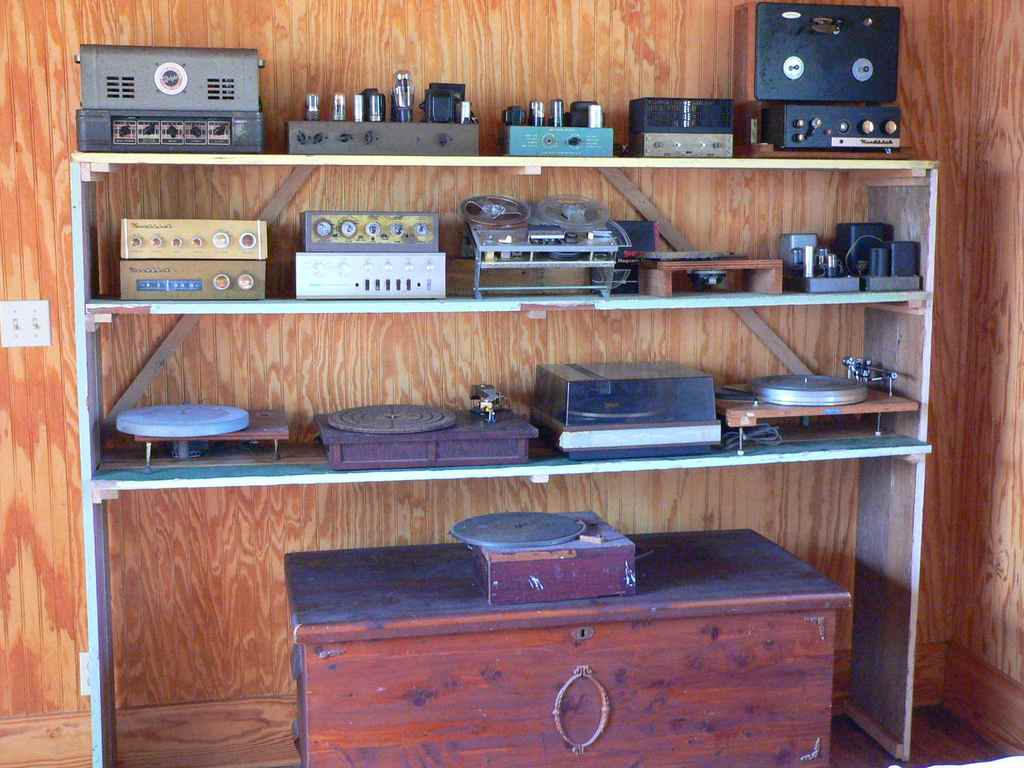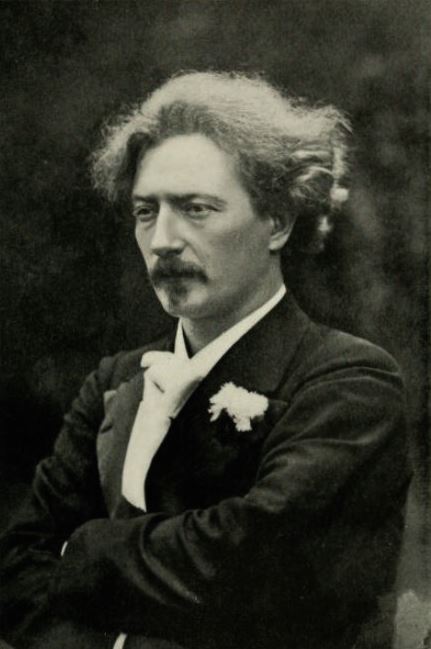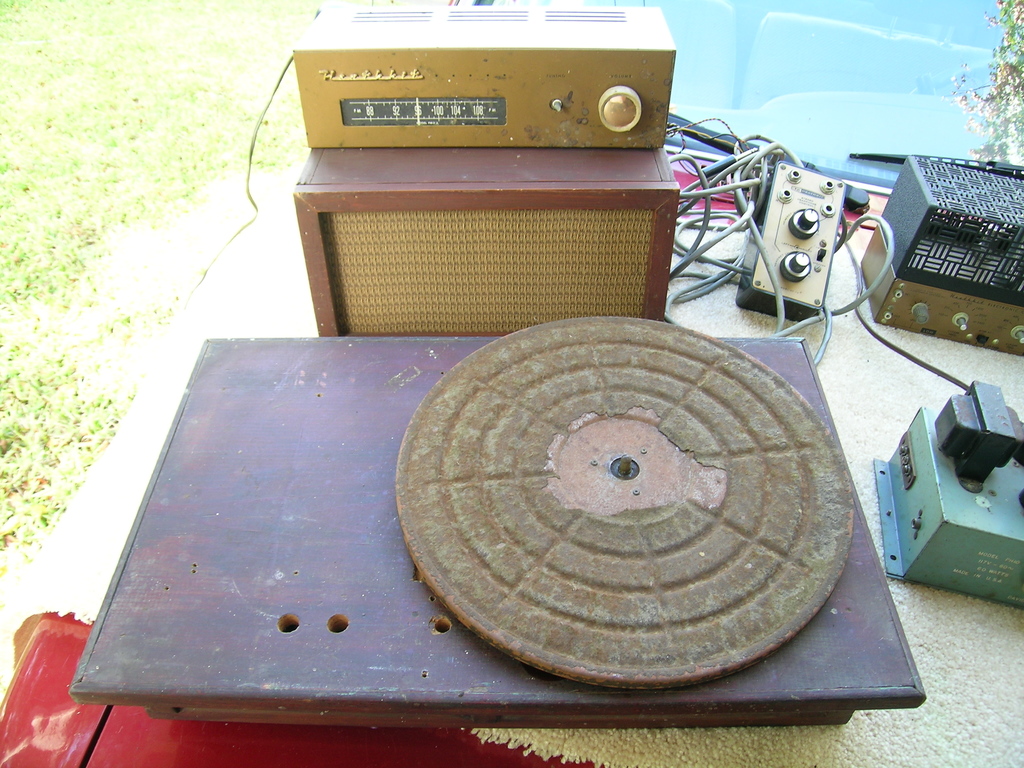Acoustic to Digital – One man’s love of music creates lifetime quest for high fidelity.

Al Howard Richey (1923-2008) was my dad. Although a chemical engineer by profession, he loved music so much that he dedicated countless hours devising better methods for listening. He spent many evenings and weekends building amplifiers, speaker cabinets, tuners, preamps, and even turntables and tone arms. I was there, of course, and this upbringing led me to a career in radio. More about me later . . .
After Al passed on in May of ’08, our family began to go through his effects. Dad never threw anything away, and his collection of vintage audio equipment tells the story of technology’s development from the Victrola era to the compact disk.
Most all these items remained in storage until I created a place for its display. A few items worked, the rest need fixing. The museum will consist of Heathkit, Dynaco, Eico, Rek-O-Kut, Sony, Bogen, Sun, Koss, Pioneer, BSR, Technics, Shure, Pickering, and lots other equipment from the 1940s on.
My goal was to create a room where a visitor could hear 78s and LPs on a monophonic system and stereo records with a two-speaker setup. A listener will to experience technological change and development first-hand.
Stay tuned . . .
The Story Unfolds
Here’s how the idea began.
My first contact in Austin in late August was with Clay Shorkey, director of the Texas Music Museum. This seemed like an ideal place to put my exhibit but, alas, the museum holds no space of its own. Instead, it shows its posters, musician biographies, and talking machines in the hallways and conference room of an East Austin office building. I helped Clay and his co-workers prepare an upcoming on Texas Country Classics.
In September, I sat down with John Wheat, who coordinated sound archives at UT’s Center for American History. Besides being a published historian, John also shares my status as a former producer on KUT Radio. We both have visited virtual collections at the Texas Broadcast Museum. He gave me many more names of folks who’d likely cotton to my quest. He, too, wisheed his center had more space.
Next was a lunch with Karl Miller, who for many years catalogued recordings at UT’s fine arts library. Additionally, Karl issues historical recordings on his own Pierian label. He and I enjoyed a stimulating conversation about preserving and archiving 78s and piano rolls. His dismay at the rapid deterioration and scarcity of old audio equipment was a great encouragement to my project. Karl gave me more contacts, as well.
That same sunny afternoon, I visited two pillars in the antique sound field. First was Jim Cartwright, owner of Immortal Performances, a vintage record store he runs out of his West Austin residence. Not only recordings, Jim’s displays include dozens of acoustic Victrolas, gramophones, Edison players, and tape machines. I got to hear a cylinder, Diamond Disk, and Orthophonic exponential horn—mighty loud with no electric amplification!
From there, I high-tailed it to Ken Caswell’s cottage near Lake Austin. He owned two reproducing pianos that, with specially encoded paper “software,” recreate exact performances by composers and students of the past. Karl and Ken expertly miked these pianos to make digital recordings for Pierian CDs. Ken also demonstrated two more Orthophonic players, one of which was a record changer. Enough time was left in the day for me to visit Austin Stereo, one of several repair shops offering to help me restore the vintage equipment.
* * * * *
I grew up in a house full of music. The melodies, harmonies, and rhythms I heard from infancy came from one big single-element speaker in a corner of the living room in Corpus Christi. Easily 90% of these sounds were classical music, since that was my dad’s favorite. Al’s yearning to clearly perceive the tunes of Bach, Beethoven, and Brahms played by orchestras, chamber ensembles, and solo instruments drove him to ceaselessly experiment with new and better devices.
AHR’s upbringing in San Antonio as the second son of a lumberman and housewife didn’t foretell anything overtly technical or musical. His mother, Ella Esther Frick Richey, however, played a baby grand piano that she had bought with her own money earned from renting rooms. “Merker,” as we called our grandmother, often performed duets with her sister Francis and neighbor, Mrs. Robinson. Throughout her life, Merker loved attending the San Antonio Symphony concerts, early on with her German-born mom.
Dad’s father Alfred played “at” the piano somewhat and enjoyed waltzes. Brother Elmore practiced violin as a youth, and a seldom-played guitar looked nice atop the piano. The family owned a wind-up record player and table-top radio, through which the family heard such popular favorites as Bob Wills and, perhaps, the NBC Symphony Orchestra broadcasts every Sunday evening beginning in 1937.
Al always claimed he couldn’t carry a tune in a bucket, but he could tell if a singer sang off-key. His only instrument ever was a harmonica that he picked up one day and immediately played. He modified it by mounting it sideways inside a tin can, sealing the edges of the hole with wax. This configuration gave the reeds a certain tone, and covering the can’s opening produced a distinctive vibrato.
My dad left home in 1941 to attend Rice University, then called Rice Institute, to study engineering. I recall his telling me about a professor or friend in Houston who introduced him to the joys of classical music. Even then, the orchestral style wasn’t widely popular among average Americans. It was considered “long-haired music,” a term that might have originated from the renowned composer/performer Ignacy Paderewski’s unconventionally lengthy locks. (Conductor Leopold Stokowski also wore his hair long.)

The first record my dad purchased was Lawrence Tibbett doing Largo al Factotum on one side and the Toreador Song on the other.
By the time AHR moved to South Texas after college to begin his career at the Celanese Chemical Company around 1946, he was hooked on the classics.
* * * * *
On October 14, I connected with two important outfits. First was Tube Dreams, a microbusiness in South Austin that specialized in selling and repairing modern and vintage vacuum-tube components. Proprietor Simon Hill’s story is similar to mine in that he also grew up watching his dad build electronic kits. Simon’s technical background also informed his work at IBM. He sold me a set of capacitors and resistors to replace critical parts on the first piece of equipment I deemed to rehabilitate, the mighty Dynaco ST-70. I just couldn’t wait to open the old chassis!
Later that evening, I attended a board meeting of the Texas Music Museum, held in the conference room where many of the museum’s exhibits can be seen. Here I was fortunate to get acquainted with other involved folks such as a music teacher, video archivist, learning resource center manager, and local venue program coordinator. The group discussed future shows, fundraising, collections policy, and major museum goals. Their path and mine ran parallel, if not tangential.
* * * * *
My 40-watt pencil-type soldering iron heated up nicely. After assuring that the tip was properly tinned, I set about removing old Dynakit components and replacing them with new ones. Nothing smells quite like the rosin core in lead/tin solder, and odors often take us back to the past like few other sensations. Soon everything seemed in order, so I reattached the bottom cover and prepared to test. One must always connect speakers to the outputs of tube-type amps. I did so with a pair of metal-cabineted TEAC bookshelf units that Dad had owned. On went the power switch, and the tubes began to light up. Soon music blared forth with good sound. I traced a slight hum in a channel to one of the 7199s, and still needed to replace the matched-pair EL34s. Otherwise, the ST-70 was alive again.
* * * * *
The next two significant steps forward in the museum’s evolution happened during the Thanksgiving holiday. In Corpus to pick up my mom, I searched the broad shelf at the back of the garage for more treasures. Inside cardboard boxes and plastic bags were more and older components. These I lined up on carpet atop the hood of Dad’s Toyota pickup for this photograph:

Just out of frame is a lime-green speaker box that I barely remember. My older sister, Betty, said it had been her first phonograph and had included an amp inside. Everything else I dusted off and loaded into Mom’s Chevrolet Equinox.
My family followed our tradition of gathering at an ancestral property in a rural setting east of San Antonio. I needed a way to display this growing collection of vintage equipment and figured some open shelves would do nicely. Using lumber salvaged from Al’s childhood home in the Beacon Hill neighborhood of San Antonio, I built a five-foot tall rack with three levels seven feet wide. My nephew Aidan Farmayan helped me with assembly and installation. A photo of the finished product graces the top of this website.
The components are lined up chronologically, mostly. On the top shelf, in order left to right, are the Knight, Sun, and Bogen amps, Heath crossover network, and Heath tape recorder. On the middle shelf are the Williamson preamp and tuner, EICO and Dyna preamps, Sony reel-to-reel tape player, my childhood 78 rpm turntable, and the Williamson amp and power supply. The bottom shelf is wider to accommodate turntables: Rek-O-Kut three-speed idler, fine-cabinet two-speed, BSR four-speed, and 33-rpm belt-driven Rek-O-Kut. On the cedar chest beneath stands a rougher two-speed turntable. There’s more: in a nearby room sits a horn tweeter encased in the same style as the 12” ducted-port Jensen cabinets and my second Heathkit, a three-tube, regeneration-circuit shortwave radio.

Al Richey met his sweetheart, Hannah Habeeb, at his Celanese Chemical Company job in Corpus not long after he moved there, and they were married in August of 1947. Within a year, they became the proud parents of a precocious baby girl whom they named Elizabeth. Yours truly came along in September of 1952 but, despite being a committed and involved father and breadwinner, Al continued to amass audio equipment and recordings.
I enjoy tying family birthdays to momentous historical events: my big sister, Betty, arrived at about the same time as the long-playing record (debuted by Columbia), my nativity roughly corresponds with RCA’s introduction of the 45, and sister Rosemary is as old as rock ‘n’ roll (1955). I fondly remember the big, single speaker in the living room corner from which issued melodies of Mozart, Beethoven, and Wagner. Betty had her own little system in the bedroom, where we listened to our 7” yellow 78-rpm kiddie songs such as Home on the Range, Wizard of Oz, and Yankee Doodle.
It was in those early days that I first experienced the aroma of rosin-flux solder, mentioned above. Eventually, the Internet might be able to transmit smells, but, meantime, I can describe that smoke as darkly sweet, reminiscent of a pine-wood fire. Indeed, it’s made from conifer sap and helps adhesion. Electronic solder itself is an alloy—60% lead, 40% tin, with a melting point of 374° F. Dad owned some antiquated soldering irons without internal heating elements that needed warming on a stove. I remember his electric one—big and bulky. Only once did I grab the wrong end.
Al always assured good sound wherever he traveled. As a family, we’d frequently visit his mom and brother, Elmore, in San Antonio. Dad set them up with a succession of record players, usually cast-offs of his own equipment. The Knight amp engages my first memory; it sat in the parlor atop a rounded-corner speaker cabinet (lost). To lessen acoustic feedback, the turntable was placed in the adjacent dining room. Uncle Elmore arranged his record collection geographically, as he did the house decorations. He had Egyptian, Texas, and European rooms.
My youngest sister, Carol, took her first breath in 1958, just after our growing family had moved to a new house, which Dad had designed. Her birth roughly corresponded to the introduction of stereophonic sound. It should be no surprise that our home got the first stereo on the block. Like other experimenters of the age, Dad cobbled together two mismatched amps and preamps to achieve dual-speaker sound. Within a year, I was helping him build his 70-watt stereo Dynaco amplifier and EICO stereo preamp, both kits.
Matching amplification demanded matching reproducers. My grandfather Alfred E. Richey was a lumberman and carpenter by trade, and his father, E. L. Richey the First, was a genuine cabinetmaker. Consequently, Al also held a reverence for wood, as do I. With a design adapted from a Jensen booklet, Dad and I built two bass reflex ducted-ports speaker cabinets of ¾” plywood. In those times, our theater of operation moved from the dining room table for clean electronic parts to the garage for cross-cutting, hammering, drilling, and painting. But always, whether via solder or sawdust, the goal was high fidelity. I’ve retained those same woodworking skills, and many tools as well, passing them along to my son, Sol.
Dad’s other priorities were obvious: last house to get air conditioning and color television, but the first with a tape recorder, dating from around 1961.
To be continued . . .
Good Sound to You!
To be continued . . .